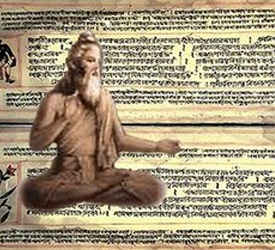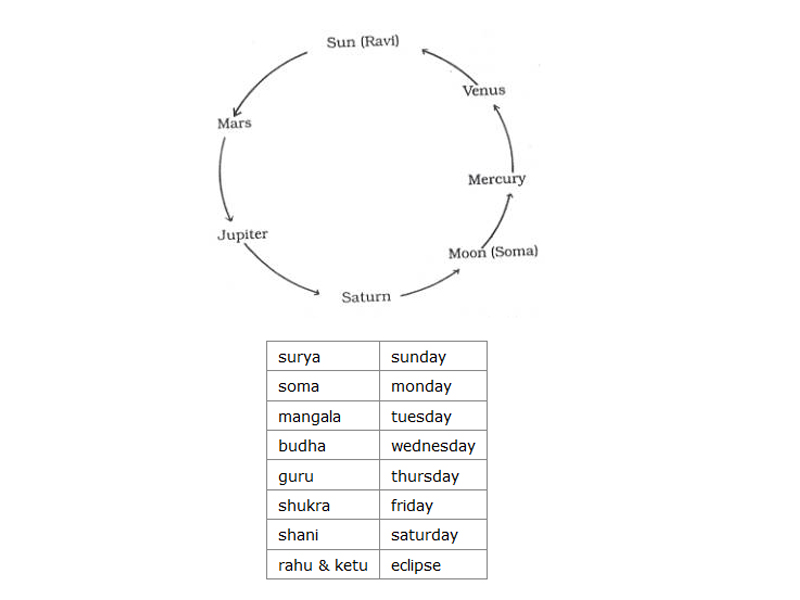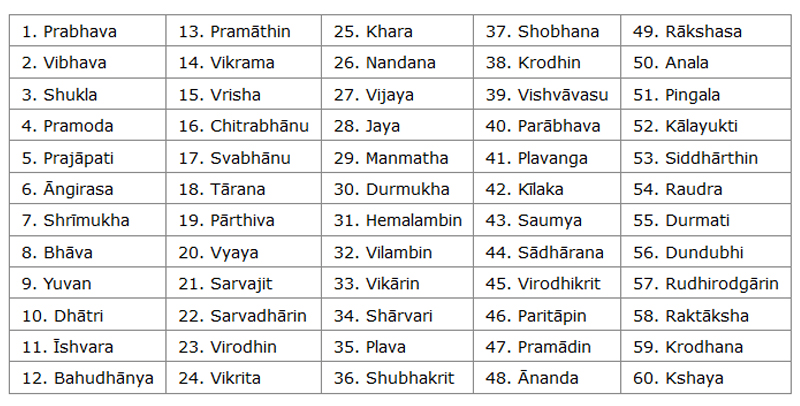Vedo Rakshati Rakshitaha

Vedic Concepts
Veda is divided into four major parts viz, Samhitas (prayers), Brahmanas (rituals), Aranyakas ( meditations) and Upanishads (The knowledge of self). The first three (Samhita, Brahmana & Aranyaka) are collectively called as Veda Purva (Starting) and the last one Upanishad is called as Veda Anta (ending) or Vedanta. The Veda Purva is also referred as Karma Kanda (Portion dealing with Rituals & Activities) and Vedanta as Jnana Kanda (Portion dealing with The Knowledge of Supreme Self).
Vedic Time
The Hindu view of time can be broadly referred to as the Vedic Time System. kala (Time) is regarded as not linear or single-directional movement, like an arrow speeding from past to future. The idea of Time itself was quite advanced in Hindu Heritage. The Hindu concept talks of Rhythm or universal order which is manifested as Time. Time Rhythm range from the fast ticking of the atom to the expansion of the entire cosmos — Time unfolding within the geological process of the Earth the change of the season, the life cycle of a fly etc. Kala (Time) itself is connected to Lord Siva in Indian Heritage. Siva is called Maha Kala — “the great Time”. His consort Kali personifies the energy of Time.
Cyclic Nature of Time
Every second repeats itself every 60 SECONDS. (60seconds = 1 minute).
Every minute repeats itself every 60 MINUTES. (60 minutes = 1 hour). Every hour repeats itself every 24 HOURS. (24 hours = 1 day). Every day repeats itself every 365 DAYS. (365 days = 1 year). Every year repeats itself in: ? ? ? ? YEARS ?
The Division of Time
In the Vedas, Time is equated with the Kala (Consciousness Time) is the source of the divisions of time. It unites procession recession and stasis.“Kalo gatinivrtti sthiti: samdadhati” (Sankhayana Aranyaka 7.20).
Time, according to Surya Siddhanta, has both its virtual and practical divisions; the former is called murta (embodied), the latter amurta (virtual or Unembodied). The Surya Siddhanta delineates that ‘what begins with prana (respiration) is called real; that what begins with truti (atoms) is called unreal.
Smallest Unit of Time
Vedic astronomy give a very detailed division of the Time upto the lowest sub division level of praņa (respiration), a time lapse of four seconds. The lowest sub divisions praņa is the same part of the day as the minute is of the circle, so that a respiration of time is equivalent to a minute of apparent revolution of the heavenly bodies above the earth. The astronomical division of sidereal time are:

As, according to modern standards, 24 hours make 1 day and night, one finds that, 1 nadi or daņda is equal to 24 minutes, 1 vinadi is equal to 24 seconds, 1 asu or praņa is equal to 4 seconds, 1 nimesha is equal to 88.889 milliseconds, 1 tatpara is equal to 2.96296 milliseconds and finally 1 truţi is equal to 29.6296 microseconds or 33,750th part of second. It is really amazing that the Indian astronomers, at such a long time ago, could conceive and obviously could measure such a small interval of time like truţi. It should be mentioned here that, 1 unit of praņa is the time an average healthy man needs to complete one respiration or to pronounce ten long syllables called guravakşara.
The Puranic division of the day is somewhat different. According to this, Kala (Time) is born out of Sun. The counting starts from nimesha (twinkling of an eye). (Source: Surya Siddhanta).
 Truti is referred to as a quarter of the time of falling of an eye lid.
Truti is referred to as a quarter of the time of falling of an eye lid.
1 muhurta equal to 48 minutes, 1 ghaţi equal to 24 minutes. 1 kala equal to 48 seconds, 1 kaşţha equal to 1.6 seconds and 1 nimeşa equal to 88.889 milliseconds as obtained above. In its daily motion, the earth rotates around its axis at a speed of nearly 1660 Km per hour and its illuminated half is called ahh (day) and the dark half is called ratri (night). From the system of units of time given above, one finds that 60 ghaţis or nadis make 1 day and night.
Vedic astronomical texts divide the above units of time broadly into two categories; (i) mūrttakalah and (ii) amūrtakalah. The units of the former kind are manifested (mūrttah) by the nature while, those of the latter kind are created by man. From this view point, ahoratra, praņa or asu. nimeşa are mūrttakalah and the rest are amurttakalah.
Hour
Deleting the leading letter ‘a’ and the trailing ‘tra’ from ‘ahoratra’, one is left with the word hora, and from this hora, another system of measuring time, the ‘Hora System’, introduced in this country by the celebrated Hindu astronomer Varaha Mihira, by dividing a day and night into 24 horas. Many believe that from this Hora System the entire world has adopted the present practice of dividing a day and night into 24 hours and moreover, from Sanskrit hora, English hour, Latin hora and Greek ora (ωρα) have been derived. It is interesting to note here that, one can derive the names of the seven days of a week from this Hora System as well. One has to assume a lord for each hora of the day and Ravivara is to be accepted as the first day of the week, but counting is to be made in the reverse or descending order and the fourth place gives the name of the following day.
Seven Days of Week
Why seven days make a week? And wherefrom the names of these seven days have come? Every Indian will be pleased to know that it is also a gift of India to the entire world. We have seen earlier that, 60 ghaţis or daņdas make one day and night or ahoratra. Indian astronomers dedicated each ghaţi of the day to a planet as its lord and derived the name of the day as per the lord of the first ghaţi of the day.

The sun or Ravi being the most powerful among the planets, as well as the giver and sustainer of life, has been honoured to be the lord of first ghaţi of the first day of the week. Hence it is named Ravivara or Sunday. In Figure-1, the lords of second and third ghaţis of Ravivara are Mars and Jupiter respectively. Proceeding in this manner, Saturn is the lord of the 60th ghaţi of Ravivara and the moon or Soma becomes the lord of the first ghaţi of the following day and hence it is named Somavara or Monday (Moonday). One may notice here that in counting 60 ghaţis along the circle of Firure-1, one has to make 8 complete revolutions and 4 more planets and hence starting from a particular planet, the 5th place gives the name of the following day. In this manner one finally arrives at Sanivara or Saturday (Saturnday) and starting from Sanivara one observes that the next day is Ravivara and thus the cycle is completed.
It may be recalled that the Hora System is not essential for naming he seven days of a week and primarily it was done by the Vedic astronomers dividing a day and night into 60 ghaţis or 60 daņdas. Hence, we may conclude without doubt that, it is the Vedic astronomers who named the seven days of a week using the original Indian system of dividing a day and night into 60 ghaţis and in their subsequent attempt they have shown that, one can arrive at the same results using 24 horas as well. In a verse (1/296) of Yajňavalkya Samhita, the names of the planets are given exactly in the order of week days and hence there is every reason to believe that the names of the planets in that verse were mentioned particularly as the lords of the seven days of a week. This makes Professor S. B. Dixit to believe that the names of the seven days of a week were known in the times of Yajňavalkya Samhita.Samvatsara
Samvatsara is a Sanskrit term for "year". In Hindu tradition, there are 60 Samvatsaras, each of which has a name. Once all 60 samvatsaras are over, the cycle starts over again. The sixty Samvatsaras are divided into 3 groups of 20 Samvatsaras each. The first 20 from Prabhava to Vyaya are attributed to Brahma. The next 20 from Sarvajit to Parabhava to Vishnu & the last 20 to Shiva. The 60 Samvatsaras are:

